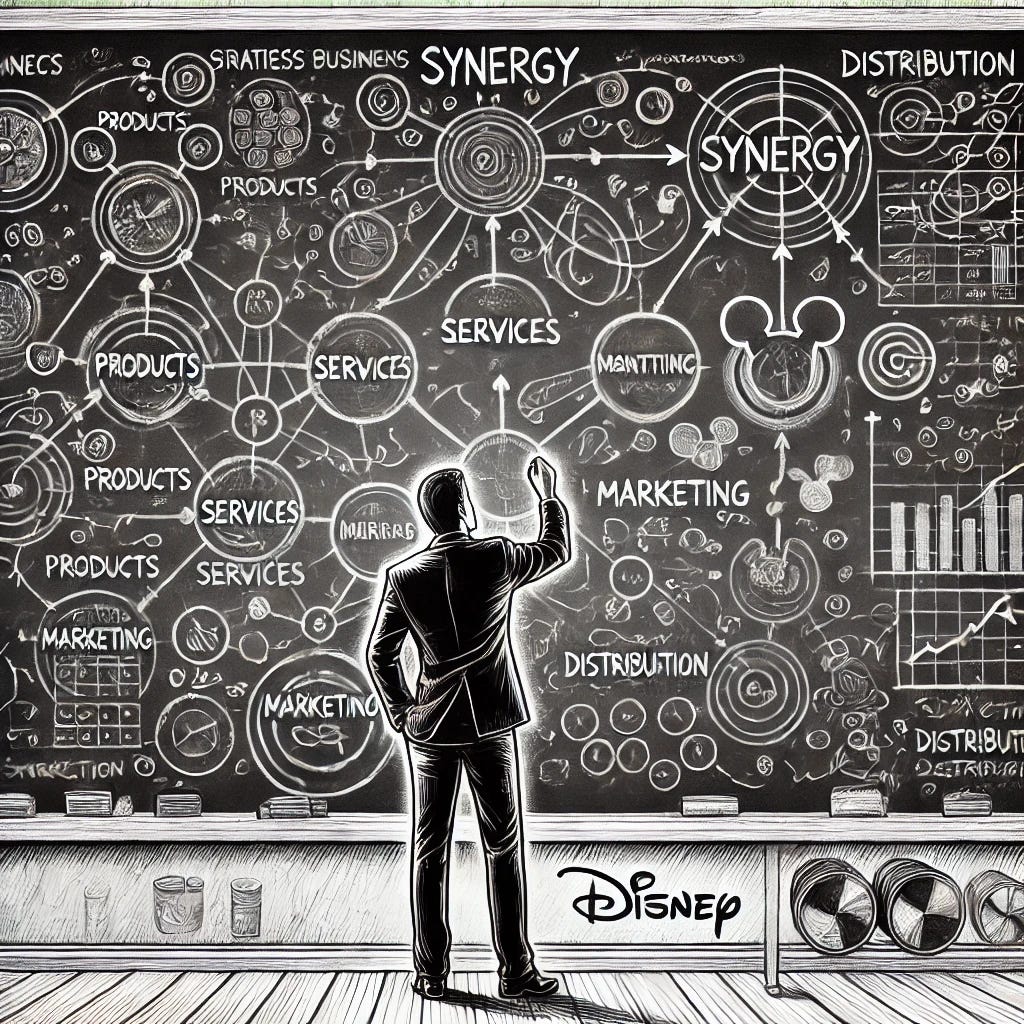The Disney Maps That Inspired Me And Help You See The Path to Business Growth
Actually, it can help you learn to "see" the right path in any situation problem you face.
20 years ago I was inspired by two old maps that Walt Disney used to create synergy between the different parts of his organization.
These images formed the basis of how I now map out "situations" in court and in the office with clients to help grow their businesses.
Disney first did it in the 1950s—creating synergy maps that have fueled their success for decades. By understanding how different parts of their business interconnected and supported each other, Disney built an ecosystem that has not only thrived in entertainment but expanded into merchandise, theme parks, and media platforms.
Think of positive feedback loops.
You can use this same approach to create your own synergy map.
The Power of a Synergy Map
Disney’s synergy map is a clear visual representation of how each part of Disney’s business interacts and supports other parts.
At its center lies the creative engine: Walt Disney Studios, which generates characters, stories, and films.
Surrounding this core are the businesses that extend and monetize Disney’s creations—theme parks, TV shows, merchandise, and licensing deals.
Think of a synergy map as the heart of your business, a visual plan that shows how each part—like different organs—works together to keep everything thriving.
By mapping out these connections, you reveal opportunities for growth, just like a well-coordinated team where every player brings out the best in the others.
It's about finding those areas where your business elements amplify each other's value, turning them into more than the sum of their parts.
Applying Disney’s Model to Your Business
Whether you're just starting out or you're already growing, Disney's synergy strategy can give you a clear picture of your potential for growth.
How?
Start by placing your core product or service at the center of your map, and then branch out into areas like customer service, digital marketing, distribution channels, partnerships, and other revenue streams.
For example, a retail company might map out how its online store and physical locations complement each other. The online store might expand reach, while the physical locations drive in-store traffic.
Next, consider relationships with suppliers, marketing initiatives, and loyalty programs—each feeding back into and strengthening the core offering.
Just draw them out on a piece of regular paper. That’s exactly how I usually start, nothing special–just get the different parts out of your mind and on paper.
Remember, the goal is to create a dynamic ecosystem, much like Disney, where each part of the business can be visualized and connected to others.
Foresight, Insight, and Cross-sight: The Three Pillars of Growth
As explained by Todd Zenger in the Harvard Business Review article, The Disney Recipe, an effective strategy must include foresight, insight, and cross-sight—pillars that can guide your business through change and expansion:
Foresight: Predict how your industry or market will evolve. Disney foresaw that its creative assets could be leveraged across multiple platforms.
For your business, this means identifying consumer trends or new technologies that could enhance your product or service.
Insight: Understand what makes your business unique. Disney’s ability to create beloved, timeless characters set it apart.
So identify the most valuable aspects of your business—whether it’s a standout product, a loyal customer base, or specialized expertise—and invest in them.
Cross-sight: Spot adjacent assets that others might overlook but could add unique value to your business. Disney’s acquisitions of Pixar and Marvel are prime examples.
For your business, this could mean seeking partnerships or opportunities that bring additional value to your core offerings, such as new channels, intellectual property, or expanded customer segments.
Building a Dynamic Growth Engine
Disney’s "growth engine" approach—using its synergy map to continually refresh its intellectual property—sets it apart. Instead of relying on one-off hits, Disney ensures a steady stream of value through continuous reinvention. (Of course, it seems that Disney has recently lost the map and going a little off course.)
For example, while the Cars movies grossed $1.4 billion at the box office, the franchise made over $10 billion in merchandise sales—showcasing Disney’s ability to maximize long-term value.
By adopting this mindset, your business can see and build its own growth engine.
Takeaways for Mapping Your Business
Start with your core: Identify your central product or service and map out how other elements—marketing, sales, customer service, partnerships—connect to it.
Focus on synergy: Look for areas where different parts of your business support each other. These synergies can unlock new opportunities for growth.
Anticipate industry changes: Use foresight to predict industry trends and how your business can adapt to them.
Double down on unique assets: Recognize what makes your business distinctive and leverage those strengths.
Explore adjacent opportunities: Seek out assets or opportunities that may be overlooked but could add significant value to your business.
Think long-term: Like Disney, build a growth engine that continuously revitalizes your core assets for sustained success.
That is all.
Be inspired and have a productive weekend.






